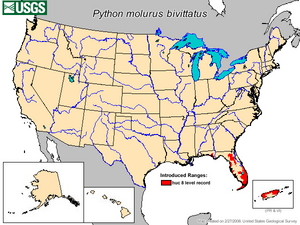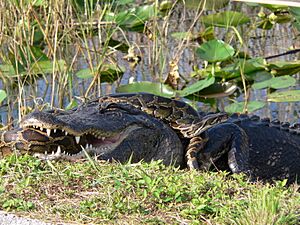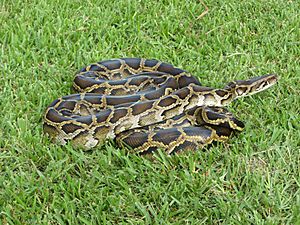Burmese pythons in Florida facts for kids
Burmese pythons (Python bivittatus) are large snakes from Southeast Asia. But since the late 1900s, they have made South Florida their new home. They now have a growing population there. People first saw Burmese pythons in Everglades National Park in the 1990s. However, it wasn't until 2000 that experts confirmed they were breeding. Since then, many more pythons have been seen. From 2008 to 2010, over 300 sightings were reported.
Burmese pythons eat many kinds of birds, mammals, and even alligators in the Everglades. The number of some mammals has dropped a lot where pythons live. This shows how much damage they are already doing to native animals. It is hard to count pythons because they are good at hiding. But most scientists think there are at least 30,000, and maybe over 300,000, pythons in South Florida. This number is expected to keep growing. In January 2012, the U.S. Department of the Interior banned importing Burmese pythons into the United States.
Contents
Burmese Pythons: An Invasive Threat
In Florida, Burmese pythons are known as an invasive species. This means they are not native to the area and cause harm. They hurt the environment by eating native animals. They also compete with native species for food and other resources. Pythons can grow as big as, or even bigger than, native snakes. They quickly become too large for most predators to eat. However, American alligators do sometimes hunt pythons in their territory.
Why Pythons Are Hard to Control
It is tough to control the python population because they have many babies. They also grow up fast and live a long time. A female python usually lays eggs every two years. She can lay between 20 and 50 eggs at once. Pythons can live for 20 years or more.
Pythons are also apex predators, meaning they are at the top of the food chain. They eat many different types of animals. This means they do not rely on just one type of prey. Pythons can go a long time without food. But when food is easy to find, they eat often. Because of this, Burmese pythons are a big danger to wildlife, especially medium-sized mammals.
Impact on Mammals
Many mammal populations in the Everglades have dropped sharply. This might be linked to the rise of pythons. Scientists compared road surveys from 1996-1997 (before many pythons) and 2003-2011 (after many pythons). They found that sightings of raccoons, opossums, bobcats, rabbits, and foxes dropped by 88% to 100%. These drops happened in the same areas where pythons had spread.
Smaller drops were seen where pythons had only recently arrived. The most mammals were found outside the areas where pythons live. Burmese pythons were the main predator of marsh rabbits that were brought back to Everglades National Park. Pythons wiped out the rabbit population in less than 11 months. It is not yet clear how these mammal declines will affect the complex food web of the Everglades.
Pythons in the Everglades
The Everglades is a large area of wet, warm lands in Florida. Only about 25% of the original Everglades remains. This part is protected within Everglades National Park (ENP). South Florida's climate and the Everglades' location make it easy for new species to invade. Miami, for example, is a major center for trading exotic pets in the United States.
No one knows exactly how Burmese pythons first got into the Everglades. But it is likely that many were once pets. Their owners probably released them when they became too big or hard to care for. Scientists have studied the genes of pythons in Everglades National Park. They found that these pythons are different from those in their native lands. However, there is not much genetic variety within the Everglades python population itself.
Hybrid Pythons
In 2001, the United States Geological Survey started a 10-year study of 400 pythons caught in the Everglades. The study found that some of these snakes were mixed breeds. They had genes from the Indian rock python in their DNA. Indian rock pythons are known to be smaller, faster, and more aggressive than Burmese pythons. This mixing of genes might help the invasive hybrid pythons adapt faster to the Everglades.
Counting Pythons
It is very hard to count Burmese pythons in the Everglades. This is because they are secretive and hide a lot. It is also difficult to do traditional "mark-recapture" studies. In these studies, animals are caught, marked, and released. But with pythons, the goal is to remove them, not put them back.
Pythons spend most of their day hiding in burrows or water. One study showed that even expert herpetologists (snake scientists) could only find 1% of pythons in a natural setting. Because of this, estimates of the python population vary widely. They range from at least 30,000 to over 300,000.
How Pythons Move and Spread
Scientists have tried to understand how Burmese pythons move in the Everglades. They do this by studying captured pythons and using radio trackers. Since pythons started breeding, researchers have recorded details about each captured snake. This includes when and where it was caught, its size, and what it ate. This helps them learn about python behavior and how they spread. More than 2,000 pythons have been caught since 2005. These include baby pythons, pregnant females, and adults over 17.5 feet long.
By studying what pythons eat, scientists found they consume almost any bird, mammal, or alligator in the Everglades. This includes endangered animals like Key Largo woodrats and wood storks.
Radiotelemetry uses small radio transmitters placed inside the snakes. This allows scientists to track their movements for a long time. A 2014 study showed that Burmese pythons might have a sense of direction. Unlike some other snakes, pythons seem to move in a planned way. Scientists tracked 12 adult pythons in Everglades National Park after moving them to new spots. Five of the six snakes moved 21–36 km away from where they were caught. They returned to within 5 km of their original location. This ability to find their way home is important. It must be considered when predicting how far pythons might spread in the southern US. It also affects how we manage the current population in South Florida.
Where Pythons Might Spread
One big question about the Burmese python population in Florida is how far they might spread. Climate can limit where a species can live. In 2008, scientists used climate data from the python's native home. They also used predictions about global warming. They thought that by the end of the 21st century, pythons could live in up to one-third of the United States. This included all three coasts. Many climate models show that most of Florida and large parts of the Southeastern United States coast have good habitats for pythons.
However, a later study looked at both extreme and average climates. This study suggested that the Burmese python's range would be limited to southern Florida and extreme South Texas. This idea was questioned because it had not been reviewed by other scientists.
Cold Weather Impact
Burmese pythons kept in an outdoor area in South Carolina during winter all died. They could not get used to the cold. But most survived long periods at temperatures colder than those in southern Florida. A report concluded that South Florida is basically the only place in the US suitable for pythons. It said there was almost no chance for them to spread further in the country based on climate models.
In 2010, a severe cold spell hit the southeastern United States. This gave more clues about how far pythons might spread. After this cold weather, many dead snakes were found. But many pythons also survived. They might have done this by hiding underground. If these behaviors can be passed down, the cold winter might have helped pythons that are better at handling cold survive. This could mean these pythons might spread further north.
However, data from 2012 disagreed with the first study. It said that Burmese pythons would stay in the Everglades. Other respected herpetologists also commented on the idea of pythons spreading. Dr. Brady Barr, a snake expert from National Geographic, said that temperatures in southern Florida are not good for large tropical snakes in the long run. He stated, "When it gets cold, these snakes die." Dr. Barr also said that feral hogs are a bigger problem for the Everglades than pythons.
Controlling Pythons
Many ways have been suggested to control the growing Burmese python population in Florida. But many areas where pythons live are hard for humans to reach. So far, all methods have had limited success.
Using Dogs to Find Pythons
Some people have suggested using dogs to find pythons. A 2011 study looked at how well dogs could find pythons. It found that dog teams (73% success) were not much better than human teams (69% success) in certain areas. Thick plants made it hard for both humans and dogs to see or smell pythons. However, dog teams were much better at searching canals (92% success). They could also cover three times more distance than humans.
Even though dogs can help find pythons, there are problems. It is dangerous for dogs in the Everglades. Smells are hard to track in shallow water. The rocky ground also makes it hard for dogs to move. Dog teams are also more expensive than human searchers. In December 2020, a dog program had its first success.
Trapping Pythons
Trapping is a common way to catch snakes. This can involve a trap with a funnel and a fence that guides snakes towards it. These fences need to be put several inches into the ground so snakes cannot go under them. But the hard, rocky ground in the Everglades makes it difficult to build good fences. Also, pythons do not move often because of how they hunt. This means they are less likely to crawl into a trap. Finally, pythons cover a huge area, which makes widespread trapping difficult. Trapping might work on a smaller scale in important areas.
Biological Control
Some scientists have suggested biocontrol for pythons. This means using a virus, parasite, or bacteria that only affects pythons to reduce their numbers. If the pathogen is not specific to pythons, it could harm other animals. Biocontrol methods have risks for the delicate Everglades ecosystem. More research is needed before using such techniques. One idea for biocontrol is to bring back native predators. For example, jaguars used to live in Florida. These big cats can kill and eat large snakes.
Python Hunts
Outside of science, many officials and media have supported using bounty hunters. But the results have been disappointing. The 2013 Python Challenge was a month-long event with cash prizes for catching pythons. It was sponsored by the Florida Fish and Wildlife Conservation Commission. Only 68 pythons were caught by 1,600 people. Another hunt in 2016 resulted in 106 pythons caught by over 1,000 people.
Some people in these hunts have made snakeskin products from the pythons. But eating the snakes is not advised. Many top predators in the Everglades have high levels of mercury through bioaccumulation. Pythons are no exception. A scientist from the U.S. Geological Survey tested python tails. Over 50 samples had up to 3.5 ppm of mercury. Florida considers fish with more than 1.5 ppm of mercury unsafe to eat. However, as of December 2020[update] the FWC is studying mercury levels again. They want to suggest what size, age, and location of pythons might be safe to eat. The eggs are safe to eat.
In July 2020, the South Florida Water Management District and the Florida Fish and Wildlife Conservation Commission announced that the 5000th python had been removed from the Everglades.
Laws to Stop the Spread
There is no perfect way to control Florida's Burmese python population yet. But laws are in place to stop them from spreading further. Florida lawmakers have made rules about releasing exotic snakes. In 2008, the Florida Fish and Wildlife Commission made rules requiring permits for boas and pythons larger than 2 inches wide. These snakes also need special tags under their skin for identification. This rule aims to stop snakes like the Burmese python from spreading to other areas. Also, the United States Department of the Interior added four more snake species, including the Burmese python, to the Lacey Act. This law makes it illegal to import Burmese pythons into the United States as of January 2012.




